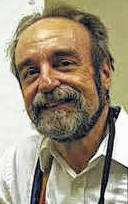
My journey to the April 8 solar eclipse began in a Kroger parking lot at Polaris in northern Columbus. We were a motley crew of seasoned eclipse chasers, astrophotographers, and eclipse newbies, 46 astronerds strong.
As we boarded the “Fun Bus,” we were greeted by Brad Hoehne, who had organized the trip under the auspices of the John Glenn Astronomy Park (JGAP).
We knew not our final destination. We would search for a clear sky and the longest possible total eclipse, wherever that might be.
To his credit, Brad could have scheduled a program at JGAP. Instead, he cautioned people not to go there. JGAP, located in Hocking Hills State Park, was outside the path of totality.
Those folks at JGAP would see only the partial phases of the eclipse. The partial phases are delightful, but the total phase, when the moon entirely blocks the sun, is one of nature’s most rare and beautiful events.
Other central Ohio organizations, including COSI, were less forthcoming. My heart went out to their participants.
We traveled first to our base camp at a hotel in Memphis, Tennessee. From there, we would rush to a site along the eclipse centerline with the best chance of a clear, cloudless sky.
We feasted on ribs and catfish on Beale Street and returned to the hotel, where we pretended to sleep for a few hours.
After a quick breakfast at 5 a.m., Brad decided to head toward Ellsinore, Missouri, population 416. According to the weather forecast, Ellsinore was our best chance for a cloudless sky and 4 minutes and 8.6 seconds of glorious totality.
So off we went on the final sprint.
After an hour of unloading and setting up telescopes, binoculars, and cameras, we hunkered down to wait.
We passed the time by observing old Sol through solar-safe telescopes. Erupting out of the sun’s disk were solar prominences — ruby-red explosions that looked tiny but were larger than planet Earth. Would they be visible during totality?
The moon’s first bite from the sun happened as predicted, precisely at 12:39 CDT. Oh, how long the one hour and fifteen minutes of partial phases seemed as the sun slowly shrank to a thinner and thinner crescent.
But as the sun finally withered to a paper-thin sliver, the hooting and hollering began. Then, a final pinpoint of light as the last bit of brilliant sunlight exploded through a lunar valley.
I hefted my large binoculars to my eyes and held my breath.
And then, totality. Despite some thin clouds, the corona, an iridescent halo of ghostly light, burst forth.
It surrounded the dark moon, blacker than black, a tunnel into infinity. Jutting into the corona were a few ruby-red solar prominences — gems decorating the sun’s crown.
Above and to the left of the sun was Jupiter. Below and to the right was Venus.
I tore my eyes from the sun and, looking at the horizon, did a quick 360. All around me was a multicolored, all-horizon “sunset,” as the sun’s light peaked around the moon’s 120-mile-wide shadow.
From our group came cries, screams, and moans of unashamed pleasure. “Oh God, Oh God, Oh God.” “Yes! Yes! Yes!” One person howled like a dog baying at the moon. Oh, wait. That was me.
Four minutes passed instantly. Then, another burst of sunlight, the “diamond ring,” and the totality was over.
The drive home took 10 hours through the dark night, but time sped by as we dreamed of future eclipses — to Spain in 2026 and down Egypt’s Nile River in 2027.
Finally, a personal note about Brad Hoehne. Organizing such trips is incredibly complex. Brad got us where we needed to be to have a transcendental experience.
His explanations on the bus and during the eclipse were clear and compelling. And he accomplished those tasks with unwavering optimism and good humor.
My devotion to public education in astronomy began long before my 25-year stint as director of Perkins Observatory. But I have reached the age when I need to rest.
My continuing worry has been whether somebody had the will and the skill to take up the challenge. That person is Brad Hoehne, who has talent and energy far exceeding my own. I will be grateful that he is on the planet for all the rest of my days.
Onward to Spain in 2026.
Tom Burns is the former director of the Perkins Observatory in Delaware.

